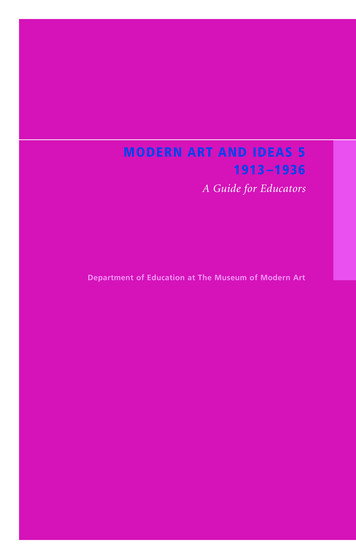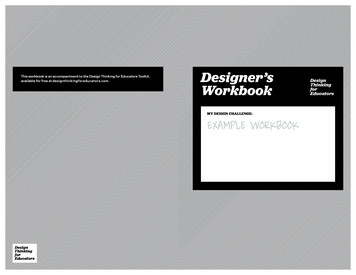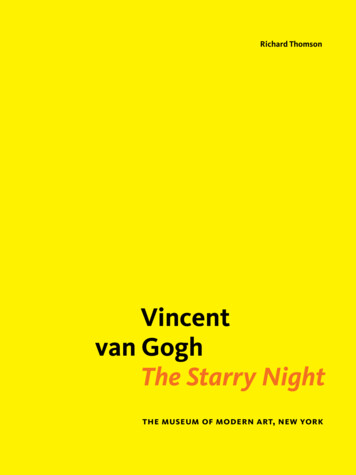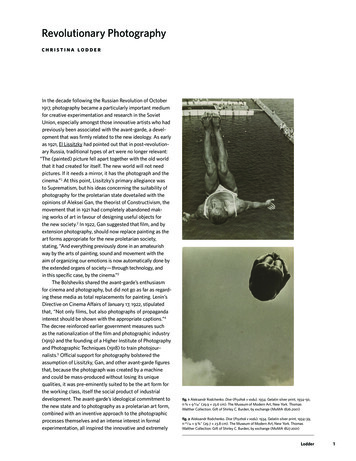
Transcription
MODERN ART AND IDEAS 51913 –1936A Guide for EducatorsDepartment of Education at The Museum of Modern Art
DADA AND SURREALISMArtists included in this guide:Jean Arp, Salvador Dalí, Marcel Duchamp, Max Ernst, George Grosz, Hannah Höch,Joan Miró, Meret Oppenheim, Man Ray, and Kurt Schwitters.TABLE OF CONTENTS1.A NOTE TO EDUCATORS2.USING THE EDUCATORS GUIDE3.SETTING THE SCENE6.LESSONSLesson One: Transforming Everyday ObjectsLesson Two: Revealing ProcessLesson Three: PortraitureLesson Four: Landscapes: Real and Imagined21.FOR FURTHER CONSIDERATION23.GLOSSARY25.SELECTED BIBLIOGRAPHY AND RESOURCES28.MoMA SCHOOL PROGRAMSNo part of these materials may be reproduced or published in any form without prior written consent ofThe Museum of Modern Art.Design 2006 The Museum of Modern Art, New York
A NOTE TO EDUCATORS1. Kirk Varnedoe, A Fine Disregard: What Makes Modern Art Modern (New York: Harry N. Abrams, Inc., 1990), 22.1A N O T E T O E D U C AT O R SThis is the fifth volume in the Modern Art and Ideas series for educators, which explores thehistory of modern art through The Museum of Modern Art’s rich collection. While traditional art historical categories are the series’ organizing principle, these parameters are usedprimarily as a means of exploring artistic developments and movements in conjunctionwith their social and historical context, with attention to the contribution of specific artists.The guide is informed by issues posed by the selected works in a variety of mediums (painting, sculpture, drawing, photography), but its organization and lesson topics are createdwith the school curriculum in mind, with particular application to social studies, visual art,history, and language arts. Lessons are accompanied by writing, research, and hands-on, artbased-activities that encourage students to make connections between the visual arts andother disciplines.The goal of this guide is to introduce students to Dada and Surrealism, two movements inmodern Western art, and to demonstrate to teachers the variety of ways in which art can beused in the classroom. The guide’s purpose is not just to explicate works of art but also todemonstrate how images and historical information can be integrated into numerous subject areas and skill bases taught in the classroom. The works featured in this guide span theyears 1913 to 1936. Dada and Surrealism were strategies, rather than cohesive styles, thatwere intended to challenge expectations and accepted values during and between WorldWars I and II. Dada ended around 1924, just as the intellectual, literary, and artistic Surrealist movement was beginning. Students will be introduced to significant ideas in art andculture from this period. By comparing a variety of mediums and artistic styles, students willbe able to practice observation, articulation, and discussion skills, and to further developtheir visual literacy.The Modern Art and Ideas series was devised with the understanding that the history ofmodern art is not simply a progression of hermetic styles; rather, a complex matrix of intellectual, social, and historical factors have contributed to the creation of art. Modern art isnot solely the product of artists who seek to overthrow convention at all cost. As KirkVarnedoe suggested, it “has been the product of individual decisions to reconsider the complex possibilities within the traditions available to them, and to act on basic options thatwere, and remain, broadly available and unconcealed.”1 Indeed, a work of art may be viewedas a locus that invites numerous approaches and offers multiple ways of understanding thehistorical moment in which it was made as well as the individual who created it.
USING THE EDUCATORS GUIDE2U S I N G T H E E D U C AT O R S G U I D EThe four lessons that comprise this guide—Transforming Everyday Objects, RevealingProcess, Portraiture, and Landscapes: Real and Imagined—may be used sequentially or asindependent units. The lessons include an introduction to key principles followed by a closeexamination of each work, including the work’s historical context and information on theartist. Discussion questions based on the image lead students through formal analysis ofthe artwork, and seek to create connections between information and visual evidence. Theactivities that conclude each lesson encourage students to synthesize what they have learnedabout the works, and connect the lesson to the broader curriculum or relate it to skills students are practicing in the classroom.We suggest that you encourage dialogue and debate by asking your students to respond toeach others’ observations and interpretations. Restating students’ responses, periodicallyreviewing students’ comments, and summarizing the discussion all help to validate students’thoughts, focus the discussion, and generate additional ideas about the artwork.IMAGESAll of the questions, discussions, and activities in this guide are based on the images on theaccompanying CD-ROM. Please examine the images carefully before showing them toyour students. Your classroom should be equipped with a computer and LCD projector.You may also print images from the CD-ROM to transparency paper for overhead projection.ACTIVITIESThe Activities sections encourage students to make connections between their own experiences and the concepts presented in the lessons. Through these activities, students will beginto develop a language for discussing and looking at art. Feel free to tailor the activities to theage level of your students.FOR FURTHER CONSIDERATION AND SELECTED BIBLIOGRAPHY AND RESOURCESAdditional discussion questions, and ideas for field trips are included in this section. A bibliography and resources section has also been provided for teachers and students to use inconducting research. The resources recommended in these pages provide further information on the artists and artworks in this guide, general historical topics, and additional classroom activities.GLOSSARYA glossary of art historical terms (bolded upon first mention in each lesson) is included atthe end of the guide.
SETTING THE SCENEDada began during World War I (1914–1918), when eight million servicemen and an estimated matching number of civilians were killed. This unprecedented loss of human life wasa result of trench warfare and technological advances in weaponry, communication, andtransportation systems. Dada artists were disillusioned by the social values that led to thewar, and sought to expose accepted, and often repressive, conventions of order and logic byshocking people into self-awareness. This international network of artists employedunorthodox techniques and materials to create new forms of visual art, performance, andpoetry as well as alternative visions of the world.Led by André Breton, Surrealism began in Paris in 1924, and was active through World War II.Influenced by Sigmund Freud’s writings on psychology, this literary, intellectual, and artistic movement was interested in how the irrational unconscious mind could move beyondthe constraints of the rational world.IMAGE ONE: Cadavre Exquis with Yves Tanguy,Joan Miró, Max Morise, and Man Ray (EmmanuelRadnitzky). Nude. 1926–27. Composite drawingof ink, pencil, and crayon on paper, sheet: 14 1 8 x 9"(35.9 x 22.9 cm); frame: 22 3 8 x 16 3 4" (56.8 x 42.5 cm).The Museum of Modern Art, New York. Purchase. 2006 The Museum of Modern Art, New York3SETTING THE SCENEDada and Surrealism were two artistic and literary movements that grew out of a dissatisfaction with traditional social values and conventional artistic practices. The artists affiliatedwith these movements did not share a common style so much as the desire to experimentwith new techniques and forms.
4 Show your students the image of Nude. Ask your students to describe what they see.SETTING THE SCENE Ask your students whether they consider the figure to be human or animal. Ask them toprovide visual evidence of their ideas. Ask your students to describe any similarities and differences between the styles of thehead, neck, torso, and legs of the figure. Ask your students to infer how this work was made, based on visual evidence.Inform your students that Nude is an Exquisite Corpse drawing made by the Surrealistartists Yves Tanguy, Joan Miró, Max Morise, and Man Ray. (Other works by Miró and ManRay are explored later on in this guide.) The drawing was created by folding a paper into foursections, and each participant contributed in turn a section of the figure without seeing theprevious contribution.Inform your students that Exquisite Corpse was originally a word game. To play, each participant wrote a word, then folded the paper so that the next participant could not see previous contributions. This tended to result in nonsensical phrases like “The exquisite corpsewill drink the new wine,” after which the game was named.21. CHANCE WORDSIn 1920, one of the founding members of Dada, Tristan Tzara, wrote instructions for makinga Dada poem, leaving the responsibility of selecting words and communicating ideas up tochance rather than the artist. Here are Tzara’s instructions:TO MAKE A DADAIST POEMTake a newspaper.Take some scissors.Choose from this paper an article of the length you want to make your poem.Cut out the article.Next carefully cut out each of the words that makes up this article and put them all in a bag.Shake gently.Next take out each cutting one after the other.Copy conscientiously in the order in which they left the bag.The poem will resemble you.And there you are—an infinitely original author of charming sensibility, even though unappreciated by the vulgar herd.32. Matthew Gale, Dada and Surrealism (London: Phaidon Press, 1997), 225.3. Ibid, 63-64.
2. ARTISTIC COLLABORATIONBeginning in the early 1920s, the Surrealists revived a modified version of Exquisite Corpse.Like the original word game, the new version required artists to surrender their creativecontrol and be open to unexpected possibilities. One person would draw a portion of thebody, fold his or her section over to hide it, and pass it on to the next participant, who wouldrepeat the steps until the drawing was complete.Divide your class into groups of four students each to play Exquisite Corpse. Many Exquisite Corpse drawings follow the human figure, and incorporate any number of elements,including animal and mechanical ones. Each student in the group should start one drawing, folding a vertical sheet of paper horizontally into four equal parts (dividing the “body”roughly into head, neck, torso, and legs). After completing a section, he or she should foldit over and pass it on to the remaining students in their group until the picture is done. Yourstudents may look only at the marks on the side of the fold they are working on as a reference and starting point for their section.After the class completes their drawings, direct your students to examine and discuss similarities and differences among the drawings. Ask your students to discuss the experience ofdrawing an Exquisite Corpse. What was it like to draw without seeing the other sections?Ask your students if they are pleased with the results of their four-person drawing or if theywould prefer to have had total creative control. Ask how they think their drawings wouldhave differed if each participant had seen the previous contributions.5SETTING THE SCENEFollowing Tzara’s instructions, direct your students to make their own Dadaist poems fromone or two paragraphs of a newspaper article. After they are finished, have your studentsread their poems aloud to the class and discuss. Ask them to reflect upon their experienceof making and hearing these poems. What are their favorite or least favorite word combinations? What is the effect of reading words that have been put together without logic?
LESSONSLESSON ONE: Transforming Everyday Objects6LESSONSIMAGE TWO: Marcel Duchamp. Bicycle Wheel.IMAGE THREE: Man Ray (born Emmanuel1951 (third version, after lost original of 1913).Metal wheel mounted on painted wooden stool,50 1 2 x 25 1 2 x 16 5 8" (128.3 x 63.8 x 42 cm). TheMuseum of Modern Art, New York. The Sidneyand Harriet Janis Collection. 2006 ArtistsRights Society (ARS), New York / ADAGP, Paris /Estate of Marcel DuchampRadnitzky). Rayograph. 1923. Gelatin silverprint, 11 9 16 x 9 1 8" (29.4 x 23.2 cm). TheMuseum of Modern Art, New York. Gift ofJames Thrall Soby. 2006 Man Ray Trust /Artists Rights Society (ARS), New York /ADAGP, ParisIMAGE FOUR: Meret Oppenheim. Object(Le Déjeuner en fourrure). 1936. Fur-covered cup,saucer, and spoon, cup: 4 3 8" (10.9 cm) in diameter; saucer: 9 3 8" (23.7 cm) in diameter; spoon:8" (20.2 cm) long; overall height: 2 7 8" (7.3 cm).The Museum of Modern Art, New York.Purchase. 2006 Artists Rights Society (ARS),New York / Pro Litteris, Zurich
INTRODUCTIONDada and Surrealist artists questioned long-held assumptions about what a work of artshould be about and how it should be made. Rather than creating every element of their artworks, they boldly selected everyday, manufactured objects and either modified and combined them with other items or simply selected them and called them “art.” In this lessonstudents will consider their own criteria for something to be called a work of art, and thenexplore three works of art that may challenge their definitions.LESSON OBJECTIVES Students will consider their own definitions of art. Students will consider how Dada and Surrealist artists challenged conventional ideas of art.INTRODUCTORY DISCUSSION Ask your students to take a moment to think about what makes something a work of art.Does art have to be seen in a specific place? Where does one encounter art? What is art supposed to accomplish? Who is it for? Ask your students to create an individual list of their criteria. Then, divide your students intosmall groups to discuss and debate the results and come up with a final list. Finally, ask eachgroup to share with the class what they think is the most important criteria and what is themost contested criteria for something to be called a work of art. Write these on the chalkboard for the class to review and discuss.IMAGE-BASED DISCUSSION Show your students the image of Bicycle Wheel. Ask your students if Marcel Duchamp’ssculpture fulfills any of their criteria for something to be called a work of art. Ask them tosupport their observations with visual evidence. Inform your students that Duchamp made this work by fastening a bicycle wheel to a kitchenstool. Ask your students to consider the fact that Duchamp rendered these two functionalobjects unusable. Make certain that your students notice that there is no tire on the bicyclewheel.To challenge accepted notions of art, Duchamp selected mass-produced, often functionalobjects from everyday life for his artworks, which he called Readymades. He did this to shiftviewers’ engagement with a work of art from what he called the “retinal” (there to please theeye) to the “intellectual” (“in the service of the mind.”)4 By doing so, Duchamp subverted thetraditional notion that beauty is a defining characteristic of art.Inform your students that Bicycle Wheel is the third version of this work. The first, now lost,was made in 1913, almost forty years earlier. Because the materials Duchamp selected to beReadymades were mass-produced, he did not consider any Readymade to be “original.” Ask your students to revisit their list of criteria for something to be called a work of art. Askthem to list criteria related specifically to the visual aspects of a work of art (such as“beauty” or realistic rendering).4. H. H. Arnason and Marla F. Prather, History of Modern Art: Painting, Sculpture, Architecture, Photography (Fourth Edition)(New York: Harry N. Abrams, Inc., 1998), 274.LESSONS Students will be introduced to Readymades and photograms.7
Duchamp said of Bicycle Wheel, “In 1913 I had the happy idea to fasten a bicycle wheel to akitchen stool and watch it turn.”5 Bicycle Wheel is a kinetic sculpture that depends on motionfor effect. Although Duchamp selected items for his Readymades without regard to their socalled beauty, he said, “To see that wheel turning was very soothing, very comforting . . . Ienjoyed looking at it, just as I enjoy looking at the flames dancing in a fireplace.”6 By encouraging viewers to spin Bicycle Wheel, Duchamp challenged the common expectation thatworks of art should not to be touched. Show your students Rayograph. Ask your students to name recognizable shapes in this work.Ask them to support their findings with visual evidence. How do they think this image wasmade?8LESSONSInform your students that Rayograph was made by Man Ray, an American artist who waswell-known for his portrait and fashion photography. Man Ray transformed everydayobjects into mysterious images by placing them on photographic paper, exposing them tolight, and oftentimes repeating this process with additional objects and exposures. Whenphotographic paper is developed in chemicals, the areas blocked from light by objects placedon the paper earlier on will remain light, and the areas exposed to light will turn black. ManRay discovered the technique of making photograms by chance, when he placed someobjects in his darkroom on light-sensitive paper and accidentally exposed them to light. Heliked the resulting images and experimented with the process for years to come. He likenedthe technique, now known as the photogram, to “painting with light,” calling the imagesrayographs, after his assumed name. Now that your students have identified some recognizable objects used to make Rayograph,ask them to consider which of those objects might have been translucent and which mighthave been opaque, based on the tone of the shapes in the photogram. Now show your students Meret Oppenheim’s sculpture Object (Déjeuner en fourrure). BothRayograph and Object were made using everyday objects and materials not traditionallyused for making art, which, when combined, challenge ideas of reality in unexpected ways.Ask your students what those everyday objects are and how they have been transformed bythe artists. Ask your students to name some traditional uses for the individual materials (cup, spoon,saucer, fur) used to make Object. Ask your students what choices they think Oppenheim madeto transform these materials and objects.In 1936, the Swiss artist Oppenheim was at a café in Paris with her friends Pablo Picasso andDora Maar. Oppenheim was wearing a bracelet she had made from fur-lined, polished metaltubing. Picasso joked that one could cover anything with fur, to which Oppenheim replied,“Even this cup and saucer.”7 Her tea was getting cold, and she reportedly called out,“Waiter, alittle more fur!” Soon after, when asked to participate in a Surrealist exhibition, she bought acup, saucer, and spoon at a department store and lined them with the fur of a Chinese gazelle.8 Duchamp, Oppenheim, and Man Ray transformed everyday objects into Readymades, Surrealist objects, and photograms. Ask your students to review the images of the three artworks inthis lesson and discuss the similarities and differences between these artists’ transformationof everyday objects.5. John Elderfield, ed., Studies in Modern Art 2: Essays on Assemblage (New York: The Museum of Modern Art, 1992), 135.6. Francis M. Naumann, The Mary and William Sisler Collection (New York: The Museum of Modern Art, 1984), 160.7. Bice Curiger, Meret Oppenheim: Defiance in the Face of Freedom (Zurich, Frankfurt, New York: PARKETT Publishers Inc., 1989), 39.8. Josephine Withers, “The Famous Fur-Lined Teacup and the Anonymous Meret Oppenheim” (New York: Arts Magazine, Vol. 52,November 1977), 88–93.
ACTIVITIES1. Art and ControversyAt the time they were made, works of art like Duchamp’s Bicycle Wheel and Oppenheim’sObject were controversial. Critics called Duchamp’s Readymades immoral and vulgar—even plagiaristic. Overwhelmed by the publicity Object received, Oppenheim sunk into atwenty-year depression that greatly inhibited her creative production.2. Make a PhotogramIf your school has a darkroom, have your students make photograms. Each student shouldcollect several small objects from school, home, and the outside to place on photographicpaper. Their collection should include a range of translucent and opaque objects to allowdifferent levels of light to shine through. Students may want to overlap objects or use theirhands to cover parts of the light-sensitive paper. Once the objects are arranged on the paperin a darkroom, have your students expose the paper to light for several seconds (probablyabout five to ten seconds, depending on the level of light) then develop, fix, rinse, and drythe paper. Allow for a few sheets of photographic paper per student so that they can experiment with different arrangements and exposures. After the photograms are complete, haveyour students discuss the different results that they achieved. Students may also make negatives of their photograms by placing them on top of a fresh sheet of photographic paper andcovering the two with a sheet of glass. After exposing this to light, they can develop the paperto get the negative of the original photogram.9LESSONSAsk your students to conduct research on a work of art that has recently been met with controversy. Each student should find at least two articles that critique the work of art. Haveyour students write a one-page summary of the issues addressed in these articles. Studentsshould consider how and why the work challenged and upset critics. Was the controversialreception related to the representation, the medium, the scale, the cost, or the location of thework? After completing the assignment, ask your students to share their findings with theclass. Keep a list of shared critiques among the work’s various receptions.
LESSON TWO: Revealing Process10LESSONSIMAGE FIVE: Kurt Schwitters. Merz Picture 32A(The Cherry Picture). 1921. Cut-and-pastedcolored and printed papers, cloth, wood, metal,cork, oil, pencil, and ink on board, 36 1 8 x 27 3 4"(91.8 x 70.5 cm). The Museum of Modern Art,New York. Mr. and Mrs. A. Atwater Kent, Jr. Fund. 2006 Artists Rights Society (ARS), New York /VG Bild-Kunst, BonnIMAGE SIX: Jean Arp (Hans Arp). Collage withSquares Arranged According to the Laws ofChance. 1916–17. Torn-and-pasted paper onblue-gray paper, 19 1 8 x 13 5 8" (48.5 x 34.6 cm).The Museum of Modern Art, New York. Purchase. 2006 Artists Rights Society (ARS), New York /VG Bild-Kunst, BonnINTRODUCTIONMany Dada and Surrealist artists were critical of the dominant social structures and political strategies that led to World Wars I and II. To critique the systems that shaped society, theyturned to new art-making strategies, including collage. As practiced by Dada artists, collagecould involve chance. Collage could also rely on prefabricated sources, particularly magazines, newspapers, and other printed mass media, thus incorporating popular and commodity culture into a work of art.LESSON OBJECTIVES Students will be introduced to the strategy of collage. Students will be introduced to the concept of chance and how it has played a role in theproduction of visual art. Students will explore how artists incorporated materials from everyday life into their worksof art, including images from the mass media.INTRODUCTORY DISCUSSION Ask your students to describe what objects, images, and texts they have on the walls of theirbedrooms or on bulletin boards. Ask them to consider what these objects and their arrangement reveal about them as individuals. Have your students name similarities and differencesbetween school bulletin boards and their own walls or bulletin boards at home with respectto choice of content and how it is arranged.
IMAGE-BASED DISCUSSION Give your class a couple of minutes to look at Merz Picture 32A (The Cherry Picture) by KurtSchwitters. Ask your students to describe what they see. Ask them to consider composition,color, material, and images. Ask your students to imagine how this picture was made. To help students explain what theyare seeing, it may be useful to introduce them to the term “collage.”Inform the class that Schwitters made this work from scraps and objects he collected fromthe streets of his hometown of Hannover, Germany. Although he scavenged the fragments,Schwitters carefully composed and affixed them with glue and nails to a painted board tomake this collage.Merz Picture 32A has many layers. It might be helpful to guide your students in identifyingthe objects in the various layers. Light and dark paint on the board form the base of the collage and contribute to an illusion of depth. Affixed are various fabrics, an image of kittens,newspaper clippings, and a flashcard of cherries, onto which Schwitters penciled in Germanthe ungrammatical phrase,“Ich liebe dir!” (I love she!). Three-dimensional objects, such as awine cork and a broken pipe, protrude from the surface.Schwitters stated that with his Merz project he aimed “to create connections, preferablybetween everything in this world.” 10 Referring to the objects your students named in the picture, ask them to draw connectionsbetween the fragments and to consider how they might be related. Now show your students Collage with Squares Arranged According to the Laws of Chance, byJean Arp. Refrain from telling them the title right away. Ask your students to take a couple ofminutes to look at the image and to describe what they see. Ask them to include composition, color, material, and images in their description.Although they used different materials and techniques for their collages, Schwitters and Arpwere friends who collaborated on many art projects and publications. Using visual evidence, ask your students to compare and contrast Merz Picture 32A and Collage with Squares Arranged According to the Laws of Chance. How are they similar and howare they different? Ask your students how they think Arp’s work was made.9. Leah Dickerman, Dada: Zurich, Berlin, Hannover, Cologne, New York, Paris (Landover, Maryland: The National Gallery of Art,2005), 159.10. Ibid, 163.LESSONSSchwitters was trained as a painter, but as World War I came to an end he adopted collage ashis preferred process, saying, “[. . .] everything had broken down in any case and new thingshad to be made out of the fragments.”9 Merz Picture 32A (The Cherry Picture) belongs to theso-called Merz series, a term Schwitters derived from a syllable of the German word “Kommerz” (commerce), which he included in one of his early collage paintings.11
Inform your students of the title of this work, and read aloud the following passage by Arp’sfriend and fellow artist Hans Richter. Apparently, Arp, frustrated with a drawing he had beenworking on for some time,[. . .] finally tore it up, and let the pieces flutter to the floor of his studio[. . . .] Some timelater he happened to notice these same scraps of paper as they lay on the floor, and wasstruck by the pattern they formed. It had all the expressive power that he had tried in vainto achieve. How meaningful! How telling! Chance movements of his hand and of the fluttering scraps of paper had achieved what all his efforts had failed to achieve, namelyexpression. He accepted this challenge from chance as a decision of fate and carefullypasted the scraps down in the pattern which chance had determined.1112 Ask your students if knowing how this collage was made changes their initial ideas about it.LESSONSWhy or why not?Arp made many collages according to chance. To remove his own artistic intervention evenfurther, he sometimes used a paper cutter to cut the squares rather than tearing them byhand. However, there are accounts that Arp may have occasionally undermined chance andarranged the squares himself. Ask your students if they believe that the artist made this work using chance, based on theirevaluation of the collage’s composition. Ask them why or why not.ACTIVITIESMerz Picture 32A (The Cherry Picture) can be viewed as a journal of objects encountered bythe artist. Ask your students to collect five objects, images, or fragments that they find overthe course of a day or weekend, and make a collage. Ask them to write a journal to accompany the visual one of found objects, explaining the objects’ significance and making connections between them. What objects did they collect? What objects did they leave behind?Both Schwitters and Arp were forced to flee their homes due to military invasions leading upto World War II. In 1937, the Nazis confiscated thousands of modern works of art, including several of Schwitters’s Merz pictures. Many of these were included in Entartete Kunst(Degenerate art), a Nazi-organized exhibition in Munich intended as a platform to mockand condemn modern art. Ask your students to conduct research on this exhibition. Howmany works were in the exhibition, and why were they selected? How many people visitedthe exhibition, and how was it received critically? What affect did the show’s reception haveon the artists whose works were in the exhibition? Where did the works of art end up afterthe exhibition? After students have conducted their research, ask them to discuss their findings and debate issues of censorship in the arts.11. Hans Richter, Dada: Art and Anti-Art (London: Thames & Hudson Ltd., 2002), 51.
LESSON THREE: Portraiture13LESSONSIMAGE SEVEN: George Grosz. “The Convict”:Monteur John Heartfield after Franz Jung’sAttempt to Get Him Up on His Feet. 1920.Watercolor, pencil, cut-and-pasted postcards,and halftone relief on paper, 16 1 2 x 12" (41.9 x30.5 cm). The Museum of Modern Art, NewYork. Gift of A. Conger Goodyear. 2006Artists Rights Society (ARS), New York / VGBild-Kunst, BonnIMAGE EIGHT: Hannah Höch. Indian Dancer(From an Ethnographic Museum). 1930. Photomontage with collage, 10 1 8 x 8 7 8" (25.7 x22.4 cm). The Museum of Modern Art, NewYork. France
1. Kirk Varnedoe, A Fine Disregard: What Makes Modern Art Modern (New York: Harry N.Abrams, Inc., 1990), 22. 1 A NOTE TO EDUCATORS This is the fifth volume in the Modern Art and Ideas series for educators,which explores the history of modern art through The










